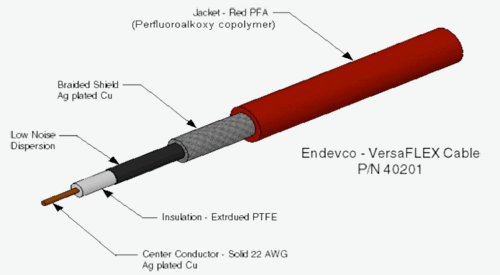Question
I notice that you offer "low-noise" cables and "standard" cables. For the best performance, should I always use low-noise cables?
Answer
Low noise cables are designed specifically for charge-mode piezoelectric accelerometers. This cable can be used with low impedance IEPE accelerometers, but this offers little if any advantage to the user and there is a considerable difference in price.
Below is an example of a low noise cable construction.

The basic difference between a low noise cable and a standard cable is the fact that the low noise cable has a special conductive coating on the cable's ETFE insulation (see above: "Low Noise Dispersion"). This conductive coating is present to reduce static electricity from being generated when the shield rubs on the center conductor. The rubbing occurs when the cable is in motion.
This phenomenon is referred to as the "triboelectric effect." This static charge can be very high when cables are un-terminated, or terminated with a very high resistance. In the case of a charge mode accelerometer, the accelerometer's resistance is in the G Ω region, and the charge amplifier has a high input resistance, thus a high static voltage can be developed if cables are moved or bent. Because of this high resistance, there is a limited path for the charge to bleed-off resulting in corruption of the vibration data. It should be noted that low noise cables mitigate the triboelectric noise but do not completely eliminate it. It is necessary that these cables be restrained for proper operation.
Alternatively, when using IEPE accelerometers, the typical impedance is around 100 Ohms thus triboelectric voltage is minimal. The low resistance prevents large charges from building-up thus making low noise cable unnecessary.
Piezoresistive and Variable Capacitance accelerometers are low impedance devices and are therefore supplied with non low-noise, standard cables.